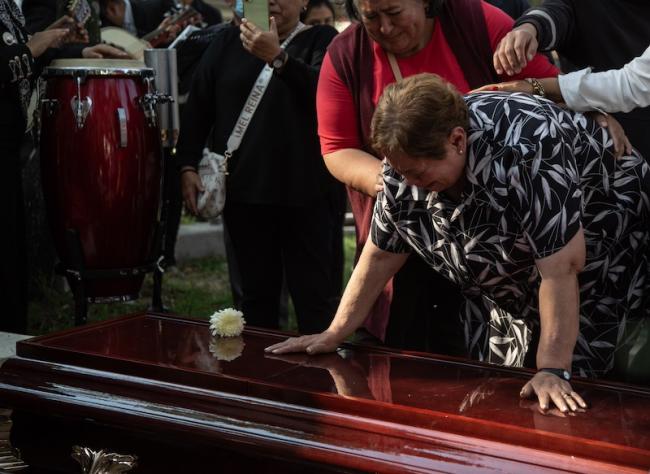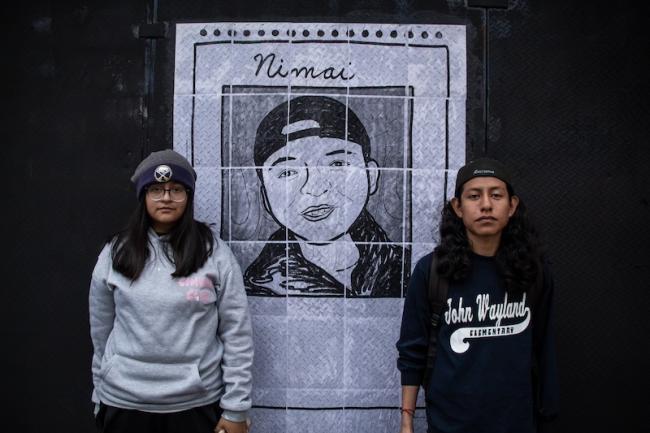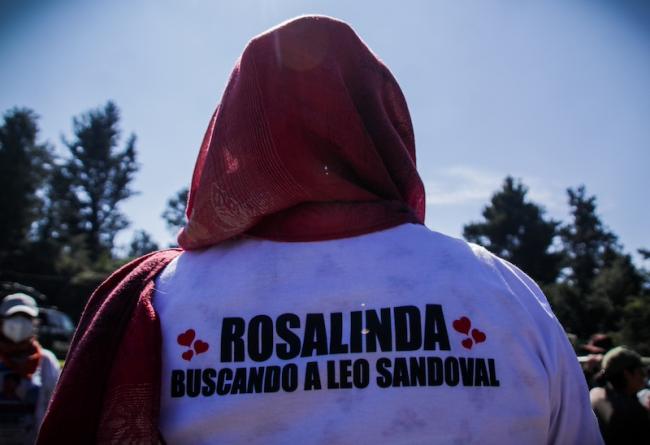
While Laura Cabañas searched desperately for her missing son, Julio César Cervantes Cabañas, his body was in a public medical school, sent by the Mexico City Institute of Forensic Sciences (INCIFO).
The institution had all the information they needed to identify him, but it didn’t.
Cervantes Cabañas disappeared on September 20, 2021. Three weeks later, his mother hand-delivered the INCIFO a hard drive of identifying data, including Cervantes Cabañas’s fingerprints, a sample of his father’s DNA, and a sample of her own DNA. She left the institution assured that it would add her son’s information to a database of other missing people, which they would then cross-check with unidentified bodies that they received. That never happened.
In January 2024, police officers found Cervantes Cabañas near death, leaning against a tree in a park. The police report said that the man died in their custody several minutes after they found him. They took him to the local police station, then to the INCIFO, where officials took his fingerprints. They never ran them against the prints that Cabañas left them. Instead, they sent the sample to the National Electoral Institute (INE), which maintains its own database of fingerprints. After five days, they deemed the body unidentified and sent it to the medical school of the National Polytechnic Institute, where it stayed for 10 months, when the INE database gave a match.
On November 1, 2024, Laura Cabañas received a knock at the door. Officials brought the news she had long awaited.
Julio César’s reappearance is one of several recent cases that have revealed the extent of the forensic crisis in Mexico City, which, according to local search collectives, has some 5,000 disappeared people. There’s a common conception that the disappeared in Mexico end up in remote clandestine graves dug by criminals, far from the state’s purview. Investigative journalism and ongoing activism by families of the disappeared reveal another pattern: the bodies of the disappeared were in the hands of the forensic authorities.
Families mobilize for dignity
A stained-glass mural outside the INCIFO’s headquarters presents a heroic tableau of the institution’s work. Two people in blue scrubs lift a woman from the remains of an ostensible plane crash. Forensic scientists surround a body laid out on a block.
The building stands on a corner of the avenue named Ciudad Judicial, home to the capital’s judicial system and courtrooms, just a few blocks from the city prosecutor’s offices. Late afternoon on Thursday, November 7, Laura Cabañas and other members of the Una Luz en el Camino search collective, made up of family members of disappearance victims, arrived to take over the busy intersection. They unfurled strips of caution tape over the intersection, blocking the early-evening traffic with a single demand: return Julio César to his mother.
When the officials knocked on Laura Cabañas’s door, the INCIFO offices were closed for the Day of the Dead, and they told her that she couldn’t see the body until Monday. After the weekend, though, the institution delayed the handover again. Authorities told her that it would take ten more days. Planted in the middle of the street, as drivers honked in dismay, the mother asked, “Who authorized this?”
“And why, if they had the file of details where my son had his DNA, and all his studies?” asked Cabañas. “Why did they take him without my authorization to a medical school, so that they could be massacring him more there?”
“It’s not right, it’s not right,” she lamented. “That’s why I’m here to speak up and demonstrate that here there are mothers in the same situation, and I don’t want them to go through the same thing.”
As evening fell over the Ciudad Judicial, the searchers entered the INCIFO to meet with officials.
The INCIFO’s obligations
The INCIFO has long maintained agreements with medical schools for the donation of cadavers for scientific purposes. Mexico’s General Health Law outlines how the process should work: before donating a body to medicine, the INCIFO must have their family’s consent. The school should also maintain a registry with the person’s name and address and their family’s information. But, as then-INCIFO director Felipe Takajashi Medina told a class of law students in fall 2023, the institution uses its discretion to override those obligations.
“The professor said that according to the General Health Law, he had the capacity to send unidentified bodies to educational institutions,” said a master’s student in the National Autonomous University of Mexico’s (UNAM) Criminal Policy program. “But when we read the law carefully, there are a lot of criteria that would impede that if the person isn’t identified,” they added.
On the day of the protest for Julio César, the mothers left the INCIFO after dark. At the meeting, the authorities agreed to hand over his body as soon as possible, and the mothers disputed the institution’s discretionary disposal of bodies.
That day, the collective demanded a change in the INCIFO’s processes for identifying bodies, notifying the families, and returning bodies to families. “It’s something that is relevant to everyone who’s looking for disappeared people,” said Jacqueline Palmeros, founder of the Una Luz en el Camino search collective. “There are collectives that come from Quintana Roo, from Chihuahua, from Veracruz, independent searchers, and that’s why we come together in this petition for the forensic identification and dignified notifications to be improved.”
Justice for the reappeared
Once INCIFO officials handed over Cervantes Cabañas’s body, his mother went from demanding her son to demanding justice for him: his body’s conditions revealed that he had been the victim of a crime.
The family of Yudhisthir “Nimai” Piña Villarruel, who disappeared on September 30, 2024, went through a similar turn.
On October 14, Piña Villarruel’s family demonstrated at the Mexico City prosecutor’s office in protest of the prosecutor’s mishandling of the case. Only then did the authorities act. “That’s when it turns out that a week before, in the SEMEFO of Cuautitlán, Mexico State, my brother’s body had already been found,” said his sister Gabriela Alonso Villarruel in an interview.

Piña Villarruel’s body arrived in the Cuautitlán Medical Forensic Service on October 7. “The Mexico City search commission, the Mexico State search commission and the city’s prosecutor’s office knew about Nimai’s characteristics, because there were search reports out in the state and in the city,” Alonso Villarruel added. “All the institutions that had to know about my brother’s physical characteristics had them. They also should have requested blood samples to compare with the unidentified bodies, which they didn’t do, even though it’s part of their search protocol.”
When the family went to recover the body, they discovered that the SEMEFO’s refrigeration equipment didn’t work. “My brother’s body was already decomposed,” Alonso Villarruel said. “My mother couldn’t see her son. They had to wrap up the casket because of the decay. We couldn’t say goodbye like we wanted to as a family.”
Once Piña Villarruel appeared, his family also demanded justice: the firing of the Mexico City Special Prosecutor for Disappeared People, May Gomez.
Recovering Leonardo Sandoval
The lack of identification is not just a problem in the Mexico City INCIFO. It extends to the greater metropolitan area. Leonardo Sandoval disappeared on May 15, 2022, in the south of Mexico City, on the Ajusco Hill. The Ajusco stands on the city’s southwestern border with Mexico State. Just a few hundred meters over that border, on June 30, 2022, the 21-year-old’s body was found on the Mexico State side of the hill. He remained unidentified in the INCIFO for two years and two months.

All the while, Leonardo’s mother Rosalinda Sandoval and his four sisters, who share Leo’s round cheeks and smile, searched tirelessly, hiking remote stretches of the Ajusco to comb the forest for signs of him.
“My mother went to the trash dumps to search with the homeless people. My sisters and I, who know the Ajusco a little more, combed the area,” said his sister Cassandra Gonzalez Sandoval.
On December 3, 2024, Sandoval and her daughter left home at four in the morning to take the three-and-a-half-hour journey to the Toluca INCIFO, where they expected to find Leo’s body. But Leo wasn’t there. “When the official received us, he said that there was a mix-up and that they hadn’t given us the correct information, but that the remains weren’t there. They ended up saying to us that the remains were in Tenango,” Gonzalez Sandoval said.
The women rode another two hours in the funeral hearse to the town of Tenango, where they finally recovered Leo’s remains. The paperwork wasn’t ready for them to take him home and they drove three hours to the civil registry to pick up the death certificate, only to find the registry closed. At eight that night, Leonardo Sandoval was finally returned home, just as Julio César Cervantes Cabañas did several weeks before.
“I feel at peace because my son is back home,” Sandoval said. “Not in the way I’d like, but I know he’s going to have a place to rest, a place where I can maybe talk to him, light a candle. I searched everywhere, in a lot of places, without knowing that my son was so close, so close.”
Eliana Gilet is an independent reporter in Mexico City. She is the founder of the Cooperativa de Periodismo.
Madeleine Wattenbarger is a journalist and translator in Mexico City. She is a member of the Cooperativa de Periodismo.
Axel Hernández is a documentary filmmaker, photojournalist and reporter, a member of the Ojos de Perro Contra la Impunidad collective, and the Cooperativa de Periodismo. His work is focused on documenting processes of collective resistance, including land defense and the search for disappeared people.

